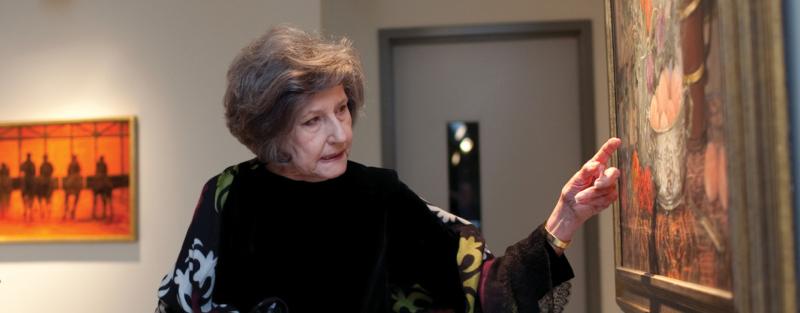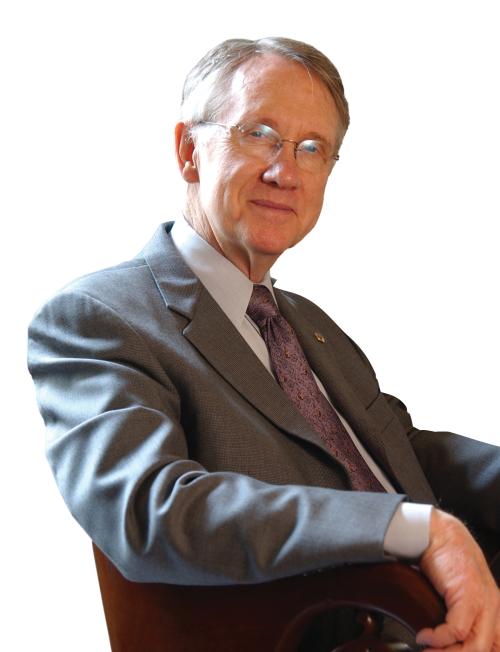In Memoriam
Remembering: Clarice Smith, B.A. ’76, M.F.A. ’79
An acclaimed painter, philanthropist and mentor, Smith left a legacy to span generations at GW.
Clarice Smith, B.A. ’76, M.F.A. ’79, honorary Doctor of Fine Arts ’12, was a nationally renowned artist, former GW faculty member and generous philanthropist who, along with her late husband, Robert H. Smith, named the Robert H. and Clarice Smith Hall of Art at GW and, with her family, was an ardent supporter of the university and the D.C. community.
Her father-in-law endowed GW's Charles E. Smith Athletic Center, which hosts myriad athletic and other events each year and is at the heart of the university student experience. Smith was named a Monumental Alumna during GW’s bicentennial celebration. She died on Dec. 9, 2021, at age 88. A renowned painter and portraitist, Smith’s work was featured in solo exhibitions in prestigious galleries in cities throughout the United States and internationally, including London, Paris, Zurich, Maastricht and Jerusalem. Her museum exhibitions included solo shows at the National Museum of Women in the Arts, Virginia Museum of Fine Arts, the New-York Historical Society and the Kreeger Museum in Washington, D.C. One of her paintings, “Big Race” (2001), is in the permanent collection of the Smithsonian American Art Museum.
Smith was a member of the GW faculty from 1980 to 1987, teaching watercolor and portrait painting in the Department of Fine Arts and Art History. In 2012, she received an honorary Doctor of Fine Arts from GW.
“I was privileged to have known her as an artist, wise mentor and curatorial collaborator throughout my GW career,” said Lenore D. Miller, M.F.A. ’72, who retired as GW’s director of university art galleries and chief curator in 2020. “She was a remarkable traditional painter whose training at GW enabled her to capture the pure joy she experienced in the visual world. I will be forever grateful to Clarice for sharing her grace, elegance and accomplishments with so many friends and colleagues.”
Smith was best known in the art world as a traditional painter, trained through life drawing and works in oil. Her works include portraits, florals, landscapes, still lifes and scenes of horses and sport. She expanded her artistic endeavors to include working with stained glass and was commissioned by the New-York Historical Society to create a stained glass window for an oculus in its Grand Hall. Recently, she added book illustrator to her list of credits, working with her son David Bruce Smith, B.A. ’79, a former member of GW’s Board of Trustees, on a well-received series of historical books for children.
Smith cited inspiration from painters like James McNeil Whistler, Edouard Manet and John Singer Sargent, and many of her compositions depicted the people and places around her. “I paint the scenes of my life,” she told “GW Today” in 2013 at the opening of her “Clarice Smith: Captured Moments” exhibition at the Luther W. Brady Art Gallery. “I’m not interested in just painting a pretty flower—I want to invoke a memory or a feeling.”
In addition to naming the Smith Hall of Art, Smith and her family have been generous benefactors to GW and other institutions. Their support spanned numerous areas of the university, including student aid, arts-related initiatives, and Jewish academic and cultural programs as well as the Charles E. Smith Athletic Center.
The family’s connections span several generations at GW. In addition to her son David Bruce Smith, her late son Steven Craig Smith, B.B.A. ’79, and her granddaughter Alexandra M. Lipp, B.A. ’15, are both GW alumni. Smith’s sister-in-law Arlene R. Kogod, whose husband is Robert P. Kogod, also attended GW.
“Clarice’s passing is a huge loss for the entire D.C.-area community,” said Donna Arbide, GW’s vice president for development and alumni relations. “The family has an incredible legacy of giving and leadership in D.C. that spans generations, and she will be greatly missed at GW.”
Remembering Harry Reid, J.D. ’64
The former Senate majority leader devoted his life to public service.
Harry Reid, who served as Senate majority leader from 2007 to 2015 and had a long relationship with George Washington University, died Dec. 28, 2021. He was 82.
Reid, who earned his J.D. from GW Law in 1964 and was awarded an honorary Doctor of Laws in 2005, was also named a GW Monumental Alumnus during GW’s bicentennial celebration for his leadership skills that took him from being a city attorney in Henderson, Nevada, to Washington, D.C., where he served as a leader in the Senate through the George W. Bush and the Barack Obama administrations. Reid also was elected to the Nevada State Assembly, as Nevada’s lieutenant governor and to the U.S. House of Representatives.
“Senator Reid recognized the great power of using education and knowledge to improve the lives of others,” former GW President Thomas LeBlanc said. “Throughout his extraordinary career in public service, Senator Reid demonstrated the strong work ethic and political and legal convictions of a leader committed to his constituents and the future of our country. We are honored to consider him among our most distinguished alumni.”
Reid, a Democrat, was an advocate of land conservation, especially for his home state of Nevada.
He received a lifetime achievement award from the League of Conservation Voters. The Conservation Lands Foundation recognized him for “historic contributions to conservation.”
He played a key role in gaining Senate passage of Obama’s most important pieces of legislation: the American Recovery and Reinvestment Act, the Dodd-Frank Act and the Affordable Care Act.
The former Senate leader was known as a tough negotiator who was a master of the Senate’s sometimes arcane rules of operation. He liked to describe himself as “more of a dancer than a fighter.
Reid was elected to the Senate in 1986. He served as Senate minority leader from 2005 to 2006 and 2015 though 2016. In all, he was the leader of Senate Democrats for 12 years.
In a 2005 interview with “GW Law Magazine,” Reid said he hadn’t set out to become a leader in national politics. “I’d love to give you some great philosophical reason about why I entered public service, but the fact is that I had no political aspirations,” he said.
The son of a miner, Reid was raised in the small town of Searchlight, Nevada, in a cabin without indoor plumbing and began his education in a two-room schoolhouse. He moved with his wife, Landra, and a young child to Washington, D.C., in 1961 to attend GW Law. While there, Reid worked nights as a Capitol police officer to support his family.
“The GW Law community mourns the passing of Senator Reid. He was a hard-working and determined law student who served six days per week as an officer with the U.S. Capitol Police while studying law full time to earn his J.D.,” said GW Law Dean Dayna Bowen Matthew. “He bore the unmistakable hallmark of a GW Law graduate who used the education he received from the oldest law school in Washington, D.C., to help reshape a nation.”
Reid spoke to GW Law graduates in 2005, telling the students they were fortunate to have the benefits of a superior education from one of the world’s finest law schools. He advised the graduates to “each use your education to stand for the rule of law. Play the game hard, but play by the rules. If the game goes against you, work harder, train harder and play again.
“And whatever you do, don’t quit.”
Mars M. Adkins, M.A. ’65 (May 11, 2022, 91), a lieutenant colonel in the U.S. Marine Corps, served as one of the earliest engineer advisers to the Vietnamese Marine Brigade during the Vietnam War. His efforts starting in 1965 were instrumental in developing the Vietnamese Marines, and he received numerous awards and citations for his service in Vietnam, including the Bronze Star for his role in five major combat operations. A true warrior poet, while serving in the field in Vietnam, Adkins found solace in writing his thesis for his M.A. in governmental administration from GW. After retiring from the military, Adkins went on to a second career in the private sector, spending 15 years in Dhahran, Saudi Arabia, as engineer facilities manager with the Arabian American Oil Company, now known as Saudi ARAMCO. Adkins is survived by his wife, three daughters and four grandchildren.
Saul Stuart Gefter, LLM ’72 (Oct. 23, 2021, 82), served as an independent attorney, U.S. diplomat and consultant specializing in international affairs during his 50-year career. He was a member of the D.C. Bar Association and was accredited to the Board of Immigration Appeals. Gefter was also fluent in Portuguese, a professor of English and an accomplished foreign-language translator. He worked for Voice of America, the United States Information Agency and at the American Embassy in Brasilia, among others. His overseas assignments included Brazil, Cuba and the former Soviet Union. Gefter was a 33rd-degree Mason and an ardent biblical scholar and educator. He is survived by his wife, three children, four grandchildren and brother.
Warren Gould, A.A. ’50, B.A. ’51, M.A. ’55 (April 11, 2022, 93), dedicated his career to raising funds for prominent nonprofit institutions across the United States. He was the former president of the American Alumni Council, now known as the Council for the Advancement and Support of Education. He also established seven endowments for education and served in several capacities at GW in the 1950s and 1960s, including as director of alumni relations, associate director of development and vice president of development. Gould’s wife, Catherine Gould, died in 2002, and his son, Jim Gould, passed away in 2019.
David Lloyd Hooker, B.A. ’88, M.S. ’07, (May 12, 2020, 55), was a well-respected software engineer for the Inter-American Development Bank in Washington, D.C. He also was the president of his own company, Mountain View Software Inc. Hooker was a talented and self-taught artist who also enjoyed cooking, chess, philosophy and literature. He is survived by his parents and brother as well as aunts, uncles and many cousins. A celebration of his life was held May 28 at the First Unitarian Universalist Church of Houston.
Sandy Schreibel Jousse, B.A. ’98 (Oct. 27, 2021, 46), fought a two-year battle against glioblastoma, an aggressive brain cancer. She lived her life every day according to the following mantra: “Positive attitudes only—negativity is not welcome here!” While at GW, she was an active and well-loved member in one of the first classes of the Phi Sigma Pi National Honor Fraternity. She relocated to Armonk, N.Y., with her husband, Jerome (whom she met while at GW), and began a successful 15-year career with Citi, during which she touched the lives of many colleagues and friends. She passed away peacefully with her husband and two sons, Cyrille and Severin, at her side. A ceremony celebrating her life, held in November, brought friends and family together from around the world.
James Loudermilk II, Applied Science in Communications Engineering ’79, (Feb. 26, 2022, 74), was an expert in the field of biometrics, holding many positions within the Federal Bureau of Investigation and the private sector, including chief engineer and deputy program manager for development of the Integrated Automated Fingerprint Identification System. A retired lieutenant colonel of the U.S. Army Reserve and an active and longtime Scottish Rite Mason (who achieved the distinction of a 33-degree wise master), he was a loving husband and devoted father of three.




